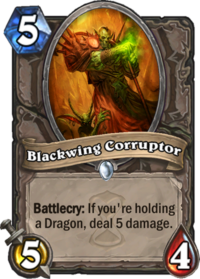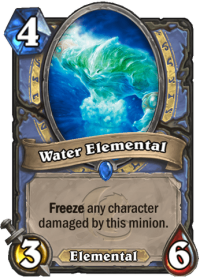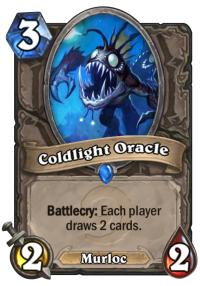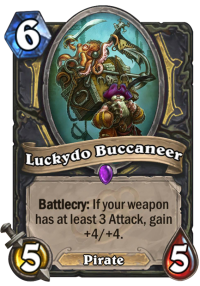Sometimes, playing tribal decks can be a lot of fun. Tribes bring unity and story to a deck, forming a more coherent whole than just rolling through the fields with giant worms and skeletal steeds – although I guess those can be related too, when you put your imagination to work on it.
However, good tribes can be difficult to come by. Tribal decks are often straightforward and a little boring, such as Dragon Priest of The Grand Tournament era, and if you give them too much power compared to the rest of the field, they can end up being universally needed – pre-nerf Patches the Pirate, anyone? Alternatively, if the tribe aligns too closely to the abilities of one class alone, they end up becoming exclusive to that class, even if they consist mostly of neutral cards.
Hearthstone has had its fair share of successes and failures when it comes to tribes, and in this article, we are taking a closer look at what tribes there are, how they have been used, and what classes can make the best use of them now.
Beasts

There are random Beast cards across a wide variety of classes, but for the most part it is Hunter and Druid that benefit from the tribal tag. Beast synergies require you to have a Beast on the board to achieve a specific effect.
Hunter has lots of Beast synergy cards, such as Kill Command, Crackling Razormaw, and Houndmaster, and really looks for that tribal tag when selecting cards for a deck.
For Druid, the synergy cards are not as deeply integrated to the core of the class. In fact, the most used ones – Mark of Y'Shaarj and Menagerie Warden – will rotate out of Standard in spring 2018, and it is unclear whether there are any Druid archetypes that will really care about the Beast tag afterwards. Beast Druid has been semi-viable for a long time now, never really having the tools to actually become a thing, but still something an enthusiast can toy around with.
Demons

As a tribal mechanic, there is not much to say about Demons. Even though there is a handful of neutral Demons in the game, all the synergy cards are Warlock class cards and no other class has any chance to build a Demon deck, even a bad one.
What is unclear, however, is what is the role of Demons in Warlock. At times, Blizzard prints Demon synergy cards, such as Crystalweaver and Bloodfury Potion in Mean Streets of Gadgetzan, and then in the next expansion they can stop Demon support altogether – yes, Journey to Un’Goro, I’m looking at you and all your Warlock Beasts.
With the immense power of Bloodreaver Gul'dan, Demons will play a key role in many Warlock decks even after Mean Streets of Gadgetzan rotates out of Standard in spring 2018 at least until Gul’dan himself rotates out of Standard in spring 2019. Whether it’s just Voidlord that fills the Demon ticket remains to be seen, as Demon Zoo keeps flickering in and out of existence.
Want to play with Demons? Check out our Zoolock and Cubelock guides!
Dragons

Dragons are one of the most interesting tribes in Hearthstone. A fantasy classic, these giant reptiles are a part of just about any fantasy game and have a large fan base. There have been plenty of Dragon synergy cards in Hearthstone ever since the (now Wild-only) Blackrock Mountain adventure in 2015, and they have one of the more strategic synergy conditions: you need to hold a Dragon card in your hand to activate the various effects.

While Blackrock Mountain did not make Dragon decks top tier, it sparked a wealth of innovation around the tribe. Malygos Warlock, despite running only a few Dragons, made good use of Blackwing Corruptors. People worked on Dragon Paladin with Dragon Consort bringing forth powerful end-game Dragons early. The first iterations of Dragon Priest were conceived.
The Grand Tournament expanded the theme further and spread it to more classes, as Dragon Warrior joined the fray thanks to Alexstrasza's Champion. Dragon Priest received a number of buffs and became the (sub-par) on-curve deck of choice for the Priest class.
At the peak of their power, it was even possible to build successful Dragon decks for classes that lacked any class-specific Dragon cards: Malygos Warlock and Dragon Druid – and later on Big Druid – were two very different takes on the subject, one focused on spell damage and the other on ramping out big minions.
The hold-in-hand effect proved to be a rich deck-building challenge. If you wanted to have the effect available early, you generally went with at least eight Dragons in a deck, but many chose to cut it down to seven, and sometimes to even fewer, if the synergy cards were meant to be played in the mid-game.
With a fairly low number of class-specific cards, Dragons succeeded in something Pirates have failed – creating diverse decks spanning multiple classes based on the same tribe.
Alas, that seems to be a thing of the past now. For the past few expansions, Blizzard has focused on printing Dragon synergy cards for Priest only: Drakonid Operative, Duskbreaker, and Twilight Acolyte boost the power of Dragon Priest to new levels – it is actually a very competitive archetype – at the expense of making any other class’s attempts at building Dragon decks sub-par.
You can play Dragon Priest in many varieties right now: Spiteful Summoner, Divine Spirit + Inner Fire combo, Cabal Shadow Priest Midrange (stealing Voidlords is fun, so fun!), and Dragon Raza Priest are all viable and competitive. Dragons have become Priest and Priest has become Dragons, outside of the pure Raza + Anduin Highlander Priest.
It is a fine line to walk. Dragons were the best-balanced tribe in Hearthstone for a long time, offering neutral cards that were used in different ways by different classes, but now Dragons are mostly a Priest thing with other classes having mere scraps left.
Want to play with Dragons? Check out our Dragon Priest guides!
Elementals

Journey to Un’Goro introduced the Elemental tribe, including adding a number of existing cards to the new group. The Elemental tribal mechanic is based on having played an Elemental on the previous turn and most classes received some Elemental goodness, especially Shaman and Mage. 
For a brief while, Elemental Shaman was something people experimented with a lot, summoning the power of Kalimos, Primal Lord to their aid.
Servant of Kalimos, which allows you to Discover an Elemental, saw classes with only a few powerful class Elementals experiment on just how many of those they could bring to the field. Ragnaros, Lightlord for Paladin and Lyra the Sunshard for Priest are attractive targets to Discover most of the time, but in the end, they proved to be too weak to carry the rest of the deck.
Elemental Mage also never quite took off. Tempo Mage did not need the Elementals, and slower Mage decks could not fit in enough minions to the deck. Frost Lich Jaina from Knights of the Frozen Throne did little to change this balance: with all the removal spells of Control Mage, there was only room for Baron Geddon and Pyros at best, and that was it.
The key problem with Elementals is their extremely stringent synergy condition. Saving an Elemental to activate the synergy is difficult, and it gets worse when you only get one activation from playing it, and if you need to change your plan, you need to play another for the synergy to become active again. Compared to Dragons, you need a lot more Elementals in the deck to activate the synergies, and that makes your deck predictable, boring, and weak. Filling half of your deck with Elementals – and you will be hard-pressed to find enough good Elementals that fit any individual plan – just is not great for deck building.
Mechs

Mechs were introduced to the game in Goblins vs Gnomes in 2014, and are currently almost extinct from Standard format – there are no synergy cards remaining there.
Mech synergy works the same way as Beasts, you need to have a Mech on the board to activate an effect. Typically, Mechs were an aggressive tribe, and for a time Mech Mage and Mech Shaman roamed the ladder, beating opposition to pulp in no time.
Murlocs

Murlocs are one of the most successful tribes in Hearthstone. The tribe has evolved and managed to stay relevant for a long period of time, starting from the first Warlock Murloc decks back in vanilla – and yes, I played that back in vanilla too. 
Shaman and Paladin have received the most Murlocs, but Murloc Shaman has never been a big hit despite the Shaman Quest from Journey to Un’Goro being a Murloc synergy card.
Murloc Paladin, on the other hand, has went through many iterations and proved to be a resilient deck, even switching archetypes from aggro to combo and back again! In the heyday of Anyfin Can Happen, Murloc Paladin was a fearsome combo deck that was able to call two waves of Murlocs in the late game, dealing 22 charge damage with the first wave and more than 30 damage with the second wave.
Currently, Murloc Paladin remains a popular aggro deck in Standard despite the health buff removal from Murloc Warleader (it used to give +1 Health to your Murlocs in addition to +2 Attack) and the removal of Old Murk-Eye to the Hall of Fame and Wild format only. Vilefin Inquisitor is one of the cornerstones of the deck, allowing Paladin to create more Murlocs at will from their Hero Power, and it will rotate out of Standard in Spring 2018, so it remains to be seen what happens to the deck after that. So far, Murlocs have always found the way to survive in some form.
One of the more interesting storylines of Murloc synergies is Finja, the Flying Star. Once upon a time, Finja was the engine that powered various Water decks, most notably Water Rogue, which ran a small Murloc package of Finja, two Murloc Warleaders, and two Bluegill Warriors. Finja pulled the other Murlocs from the deck with its attacks, giving the deck a powerful tempo swing in the midgame. All of the cards being neutral, this package was incorporated into various classes, with varying levels of success.
The epitome of swarm, Murlocs have been an interesting and surprisingly complex part of the Hearthstone metagame right from the start.
Want to play with Murlocs? Check out our Murloc Paladin guide!
Pirates

Pirates are – for a while longer, until the Patches nerf hits later this month – the most popular tribe in Hearthstone. Or maybe the word is populous? They are not held in very high regard, anyway, and all of the negative sentiment boils down to a single card: Patches the Pirate. 
The state of Pirates is the clearest example of a failed tribe design in Hearthstone. They are everywhere, and yet they do not appear in many different shapes between different classes, but in the one and the same form with no variation and no flavor. The early-game tempo swing that comes from pulling Patches from the deck is so strong that the tribe – originally designed to work with weapon synergies – sees play in all classes.
Sure, there’s Pirate Warrior (an old meta tyrant that is a decent deck in the current meta), but Pirates also see play in classes such as Druid and even Priest!
It is nigh impossible to write a neutral account of Pirates right now. The tribe synergy is weapons: they buff weapons, or get buffed by weapons, or become cheaper when you have a weapon, and that is all fine and good. They have seen play in fully pirate-centric Warrior decks and in aggressive Paladin decks that just want to take advantage of free Dread Corsairs with Truesilver Champion.
Yet, the most defining feature of Pirates right now is a synergy that is not part of their core synergy: a charging Patches pulled from the deck when you play your first Pirate. Patches will lose Charge soon, making it much less attractive for any but heavy Pirate or token decks, and we’ll see if Pirates can find an identity for themselves afterwards.
Totems

Totems are a single-class tribe, they’re all Shaman. They are a swarm tribe with synergy cards that benefit from there being multiple totems in play. At times, Totems have been strong – Thunder Bluff Valiant used to be part of a powerhouse Shaman deck – but in the current meta, they are rather weak.
Previously, Totems enabled minions to become stronger or were able to be buffed into powerful minions themselves, but the current Standard format lacks cards with such effects, mostly having cards that enable you to get more Totems on the board. However, having an army of 1/1s and 0/2s does not count for much, so there is very little Totems can do for you right now.
Totem tribe shows how difficult it can be to balance a swarm tribe – the same can be seen from the history of Murlocs and the balance changes made to them. Powerful synergy cards can create immensely powerful boards, but weak synergy cards leave you with wide but useless boards. We have seen both ends of the spectrum with Totems, and it remains to be seen if we can find the middle ground someday.
The Curator, Zoobot, and Menagerie Magician

One Night in Karazhan featured a very interesting trio of cards that encourage players to combine multiple tribes together. These cards benefit from a combination of Beasts, Dragons, and Murlocs, and succeeded in creating plenty of deck-building space. 
By far the most used card of the three is The Curator, which can serve as card draw in numerous archetypes spanning from Control Paladin to Tempo Rogue. With the right mix of at least two of the tribes, The Curator can be a powerful tool.
Zoobot and Menagerie Magician have seen niche play at best, but they can provide support for the right decks.
This combination of tribes has been one of the most successful tribal mechanics in Hearthstone and resulted in several innovative decks across a wide variety of classes. Sadly, they are rotating out of Standard in spring 2018, but hopefully Blizzard will find a way to carry on their legacy and enable more unforeseen combinations of cards instead of straightforward archetypes.
The Future of Tribes in Hearthstone
So far, it seems that Blizzard is willing to keep experimenting with tribes in Hearthstone. It is a fine line to walk: Ubiquitous, dull tribes such as Patches-powered Pirates are bad for the game, and meaningless tribes such as the current Totems make no difference. Single-class tribes can be fun at times, but if too many tribes become usable by one class only, it is also a bit dull. Yet, multi-tribe successes such as The Curator and rich deck-building landscapes such as Dragons at their peak can provide a wealth of enjoyment. Hopefully, Blizzard will find ways to reinvent their past successes and not fall for the traps of their past failures again.

Nice article, since it was posted 5 years ago, it would be very interested to see how Tribal Decks have evolved with last expansions both Wild and Standard.
I played elemental priest to rank 112 legend in Un’goro.
Evn though Elementals never took off, they actually provide a decent midrange shell. I´ve been playing around with both Elemental Midrange Warrior and Elemental Jade Druid in Un´goro and even if they weren´t Top Tier they performed really well.
I’ve been mucking about with an Elemental Shaman recently since Murmuring Elemental has some interesting synergies with all the Battlecries you can pack into the deck (and I was only a few ladder wins off 500 so I figured I may as well)… dropping it with Kalimos to either do 12 damage to your opponent or 6 damage to all their minions is quite nice.
Or if you’ve got a wounded Fire Elemental and Blazecaller on the field after they’ve wrested control of the board, drop a Murmuring Ellie with Thrall, Deathseer to heal/buff up those wounded ellies (and the Murmuring Ellie) by 4 mana each.
Not gonna get anywhere near Legendary with it but it’s fun to try something different.
and overload tribe
Overload is a keyword, not a tribe.
Jade and C’Thun are almost tribes unto themselves as well, due to their unique synergies.
i agree
yes but no.
Elemental rogue was actually a very viable deck in the un goro meta.